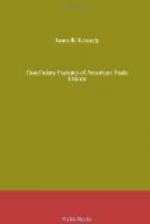It ultimately became evident that some plan for applying this fund to the establishment of a home for aged printers would best satisfy the membership. In 1887 the Austin, Texas, union announced that the Mayor and City Council of Austin were willing to present a site for such a home. In 1889 the Board of Trade of Colorado Springs offered to donate eighty acres of land for the same purpose, and other offers of land were received from time to time. The International Union finally decided to accept the offer of the site at Colorado Springs, and this decision was approved by a referendum vote.
The Home was opened on May 12, 1892. Applicants for admission were required to have been members of the union in good standing for five years. Persons incapacitated either by age or by illness were admitted to the Home. The number of residents has increased from twenty-two in 1893 to one hundred and forty-three in 1907. A considerable part of the residents are sufferers from tuberculosis, and the union has made provision for treating them according to modern methods. A part of the inmates, however, have always been persons whose incapacity was solely the result of old age.
About 1904 an agitation began to be carried on in the union for making more adequate provision for the maintenance of aged members. The establishment of the Home had made provision only for those incapacitated members who were willing to leave their families and live in an institution. It was argued that the Home benefited one class of the aged, and that another class, equally worthy, was left entirely dependent upon its own resources. Moreover, certain innovations in the trade had made the union highly sensible of the helplessness of its aged members. The introduction of the linotype caused many old members to lose their employment. The New York local union established an out-of-work benefit in 1896 which has since been maintained. This benefit, while nominally an out-of-work benefit, was in many cases really a superannuation benefit. In 1903 the Chicago local union made provision for the payment of old-age pensions to its members, and other local unions rapidly followed the same policy.
In 1903 and 1904 propositions were introduced at the sessions of the International Union for the establishment of an International old-age pension system. In 1905 the session of the International authorized the appointment of a committee to investigate the subject. The eight-hour strike which taxed for two years the resources of the Union delayed the consideration of this report. In 1907 the committee reported in favor of the establishment of old age pensions, and presented a plan which when submitted to the referendum was ratified by a large majority, and on August 1, 1908, the International secretary-treasurer began the payment of pensions. All members sixty years of age who have been in continuous good standing for twenty years, and who earn less than four dollars per week, are entitled to a weekly pension of four dollars. The original plan provided also that in order to receive a pension a member must have no other means of support. The officers of the Union, however, have construed this provision liberally, and the pension is paid as of right and not as a form of charity.




